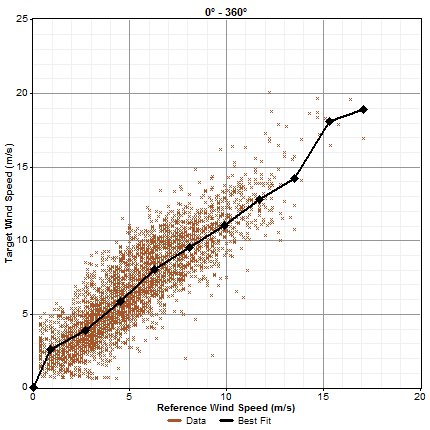
| Vertical Slice MCP Algorithm |  |
The 'Vertical Slice' algorithm, described fully in Leblanc et al. (2009), is an MCP algorithm that performs a piecewise linear curve fit on the scatter plot of target wind speeds versus reference wind speeds.
To obtain the piecewise linear curve fit, Windographer first splits the target wind speed versus reference wind speed scatter plot into N equally sized bins (vertical slices) along the x-axis. Then it calculates the mean target wind speed value for each of these bins. Windographer then assigns a point to each bin where the x value is the midpoint of the bin along the x-axis and the y value is the mean target wind speed in that bin. The piecewise linear curve then simply consists of these points connected by straight lines.
In an ideal situation, each vertical slice would contain enough data to calculate a reliable mean target wind speed value for the bin. In real datasets, however, this will not always happen, especially if the data set is short, heavily filtered, or has been divided into a large number of direction sectors. Therefore for slices with insufficient data (fewer than 5 data points), Windographer calculates the mean target wind speed by another method: using the value predicted for the midpoint of the bin by the overall linear least squares fit.
Also, the curve fit generated via the above method does not cover reference speed values below the midpoint of the first bin, or above the midpoint last bin. Therefore to handle low wind speeds, Windographer adds the origin as another point in the piecewise linear curve fit. To handle high wind speeds, it extrapolates the curve fit upwards from the last calculated point using the slope of the overall linear least squares fit.
The graph below shows an example of a vertical slice curve fit, along with the points that define each linear segment.

You can choose the number of bins into which Windographer will divide the reference wind speeds. It always uses equally-sized bins, and as a result the number of time steps will tend to vary by bin.
If you choose multiple direction sectors, Windographer will subdivide the concurrent data by direction sector and perform the curve fit process separately for each sector. It uses the reference direction sensor to determine the direction sector.
Similarly, if you choose multiple yearly divisions, Windographer will also subdivide the concurrent data according to month. If you choose 4 yearly divisions, for example, then January-March data will go in the first subdivision, April-June in the second, July-September in the third, and October-December in the fourth.
See also